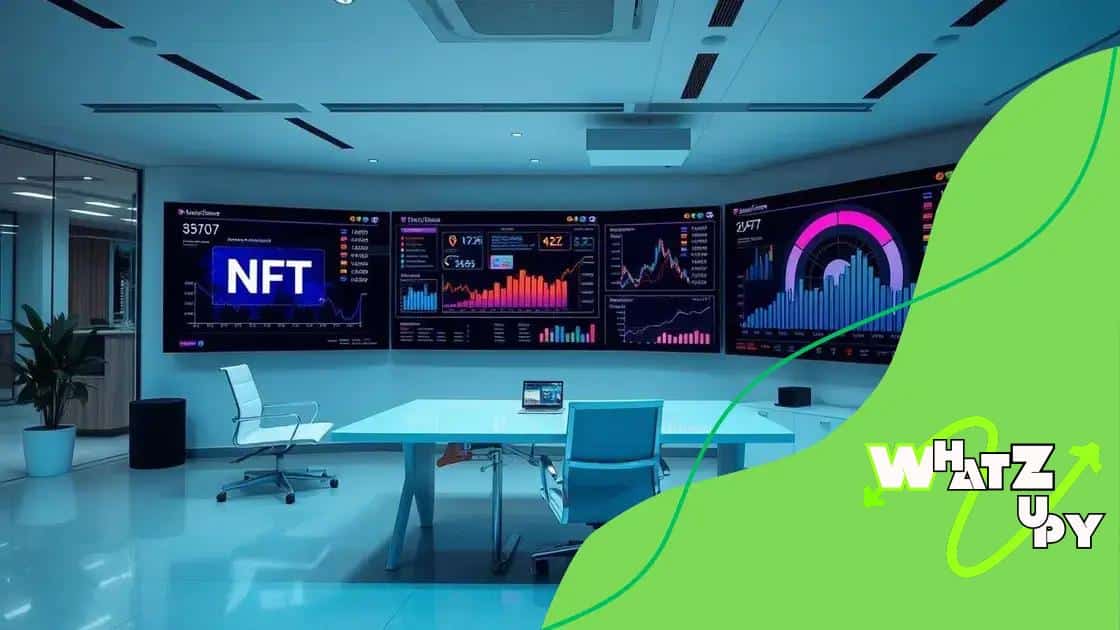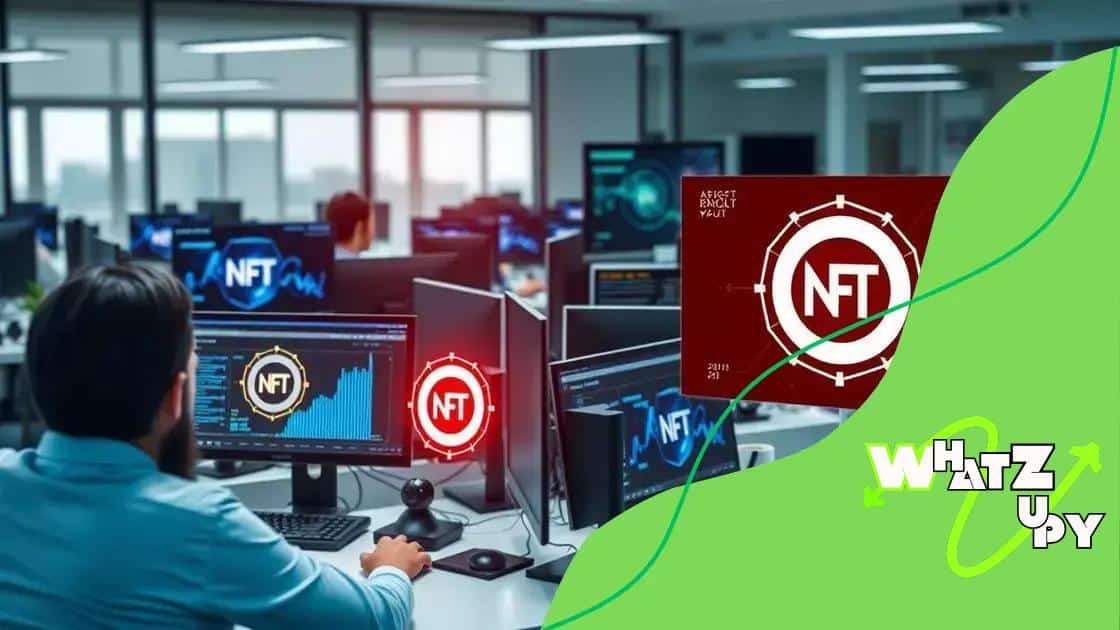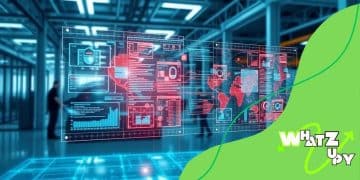The role of NFTs in business asset management

The role of NFTs in business asset management involves enhancing transparency, streamlining asset tracking, and creating innovative fundraising opportunities, while also presenting challenges such as regulatory issues and integration complexities.
The role of NFTs in business asset management is becoming increasingly important. Have you considered how these digital assets could transform your approach to finance and asset tracking? Let’s dive in.
Understanding NFTs and their Features
Understanding NFTs and their features is essential for businesses looking to leverage new technologies in asset management. These unique digital assets have gained immense popularity, but what exactly makes them special?
What are NFTs?
Non-fungible tokens, or NFTs, are cryptographic assets that represent ownership of a unique item or piece of content on the blockchain. Unlike cryptocurrencies, where each coin is identical and interchangeable, each NFT is distinct and can’t be exchanged on a one-to-one basis.
Key Features of NFTs
NFTs come with several important features that set them apart from traditional assets:
- Uniqueness: Each NFT has a unique identifier, verifying its originality.
- Ownership: The blockchain technology allows users to transfer ownership securely.
- Indivisibility: NFTs cannot be divided into smaller units, unlike cryptocurrencies.
- Interoperability: They can be used across different platforms and marketplaces.
These features make NFTs highly valuable in digital art, music, and even virtual real estate. As businesses explore the potential of NFTs, understanding these elements is crucial.
Furthermore, NFTs can enhance transparency and trust in transactions. Using blockchain technology ensures that each transaction is recorded and publicly accessible, which can reduce fraud and increase confidence among stakeholders.
Moreover, NFTs provide a new avenue for brands to engage with their audience. Companies can create exclusive content or experiences that are only accessible through ownership of specific NFTs, fostering customer loyalty.
In a world increasingly focused on digital assets, the role of NFTs in business asset management is just beginning to unfold. By grasping what NFTs are and their defining features, businesses can stay ahead in the ever-evolving landscape of asset management.
The impact of NFTs on asset ownership
The impact of NFTs on asset ownership is profound and far-reaching. As more businesses explore the use of NFTs, it’s important to understand how these digital assets are changing the traditional landscape of asset management.
Transforming Ownership Models
NFTs create a new model of ownership that is decentralizing control over assets. Traditionally, ownership of physical or digital assets often involves intermediaries, leading to complexities and delays. With NFTs, ownership is recorded directly on the blockchain, making it simpler and more transparent.
The Benefits of NFTs for Asset Ownership
Several key benefits of using NFTs for asset ownership include:
- Transparency: Each transaction is publicly recorded, which enhances trust and reduces fraud.
- Liquidity: NFTs can be traded easily across various platforms, increasing market access.
- Fractional Ownership: Multiple parties can own a fraction of a high-value asset through NFT trading.
- Security: Blockchain technology ensures that ownership records are secure and immutable.
These advantages are making NFTs an attractive option for businesses wanting to explore innovative asset management strategies. By representing assets digitally, companies can streamline operations and improve efficiency.
Moreover, the ability to prove ownership without the need for intermediaries fosters a direct relationship between creators and buyers. This is particularly significant in creative industries where artists can directly monetize their work, thereby gaining greater financial rewards.
As this new form of ownership continues to gain traction, understanding its implications will be vital for businesses looking to adapt and thrive in an increasingly digital world. The potential for NFTs to redefine asset ownership demonstrates a promising shift towards more inclusive and accessible economic models.
Integrating NFTs into existing asset management systems

Integrating NFTs into existing asset management systems presents exciting opportunities for businesses. These digital assets can bring efficiency and transparency to traditional processes. However, the integration process requires careful planning and execution.
Steps to Integration
To successfully incorporate NFTs into asset management, businesses can follow these steps:
- Assess Current Systems: Evaluate existing asset management tools and identify which can support NFT functionality.
- Select an NFT Platform: Choose a reliable NFT platform that aligns with business goals, ensuring it offers security and scalability.
- Training and Development: Provide training for staff on managing NFTs and understanding their value within the business context.
- Integrate with Blockchain: Ensure the asset management system can communicate effectively with blockchain technology for seamless transactions.
The adoption of NFTs can significantly enhance asset tracking. With the unique identifiers on the blockchain, businesses can have real-time insights into their assets’ locations and ownership status. This immediate access to information empowers managers to make informed decisions quickly.
Moreover, integrating NFTs can streamline workflows by automating processes. Smart contracts can facilitate automatic executions of agreements tied to specific assets, reducing the need for manual intervention. This not only saves time but also reduces the likelihood of human error.
As businesses move towards digital transformation, embracing NFTs can open new revenue streams. Companies can tokenize physical assets, allowing for fractional ownership and greater investment accessibility. This can attract a wider audience and increase liquidity in the market.
In conclusion, integrating NFTs into existing asset management systems can revolutionize how businesses manage and track their assets, helping them stay competitive in a digital-first world.
Challenges in implementing NFTs for businesses
Challenges in implementing NFTs for businesses can arise from several factors. While the potential benefits are significant, companies must navigate various obstacles to successfully integrate these digital assets into their operations.
Understanding Regulatory Issues
One major challenge is the lack of clear regulatory frameworks surrounding NFTs. Different countries have varying regulations regarding digital assets, which can create confusion and uncertainty. Companies need to ensure compliance with local laws to avoid legal complications.
Technical Integration Difficulties
Another hurdle is the technical complexity involved in integrating NFTs into existing systems. Many businesses may not have the necessary infrastructure or expertise to implement blockchain technology effectively. This can lead to increased costs and extended timelines for integration.
Market Volatility and Consumer Acceptance
Market volatility poses a significant risk as well. The value of NFTs can fluctuate dramatically, impacting business decisions related to investment and pricing. Additionally, gaining consumer acceptance for NFTs as legitimate assets can be challenging, especially among those unfamiliar with digital currencies.
- Educating Stakeholders: Businesses must invest time in educating employees and customers about NFTs to build trust and interest.
- Developing Secure Platforms: Ensuring the security of transactions and data is essential to prevent fraud and data breaches.
- Navigating Digital Asset Ownership: Challenges in clarifying ownership rights and responsibilities can complicate transactions.
- Identifying Use Cases: Businesses need to define clear use cases for NFTs to justify their implementation and attract potential users.
These various challenges require businesses to carefully evaluate their approach to NFT integration. By understanding the potential pitfalls, companies can develop strategies to mitigate risks and maximize the advantages of using NFTs in their asset management frameworks.
Future trends: NFTs in corporate finance
Future trends in NFTs within corporate finance are promising and complex. Companies are beginning to explore how these digital assets can reshape investment strategies, asset management, and fundraising efforts.
Innovative Fundraising Methods
Many businesses are considering using NFTs as a means to raise capital. Unlike traditional methods, companies can create unique tokens representing shares or assets, offering them directly to investors. This method may increase liquidity and broaden the investor base.
Expanding Asset Tokenization
Tokenization of assets is another trend on the rise. Corporations can convert real-world assets, like real estate or intellectual property, into NFTs. This process allows for fractional ownership, making it easier for smaller investors to participate in high-value assets.
Alongside these advancements, the incorporation of NFTs in corporate finance also leads to greater transparency. Each transaction involving an NFT is recorded on the blockchain, ensuring that ownership and contract terms are publicly accessible. This can reduce disputes and enhance trust among stakeholders.
- Increased Adoption: Businesses are likely to see greater adoption of NFT technology, leading to a shift in financial practices.
- Collaboration with Traditional Finance: As the technology matures, traditional financial institutions may collaborate with NFT platforms to offer hybrid services.
- Regulatory Developments: Anticipation of new regulations will impact how NFTs are utilized in corporate finance.
- Focus on Sustainability: Companies may explore eco-friendly NFTs, aligning with global sustainability goals.
As we head into the future, it will be essential to monitor how NFTs evolve within corporate finance. Understanding these trends will help businesses adapt and leverage the transformative potential of this technology.
In conclusion, NFTs are reshaping the landscape of business asset management and corporate finance. As companies adapt to these advancements, they can experience improved efficiencies, greater transparency, and innovative fundraising opportunities. Understanding the challenges and future trends will be crucial for businesses navigating this exciting digital frontier. By embracing NFTs, companies can unlock new potential and engage with a broader audience in the evolving market.
FAQ – Common Questions about NFTs in Business Asset Management
What are NFTs and how do they work?
NFTs, or non-fungible tokens, are unique digital assets that represent ownership of a specific item or piece of content on the blockchain.
How can businesses benefit from using NFTs?
Businesses can benefit from NFTs by enhancing asset tracking, increasing transparency, and creating new fundraising opportunities.
What challenges might a company face when implementing NFTs?
Companies may encounter challenges such as regulatory uncertainties, technical integration difficulties, and market volatility.
What trends should businesses watch for in the NFT market?
Businesses should monitor trends such as increased tokenization of assets, innovative fundraising methods, and emerging regulations surrounding NFTs.





